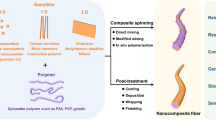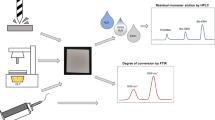Abstract
The polymerization process of the dual-cured resin cement AllCem (FGM, Joinvile, Brazil) was investigated by unilateral nuclear magnetic resonance (NMR-MOUSE) and electron paramagnetic resonance (EPR). The NMR experiment allows measurements of the mobile monomers as function of time and depth, while real-time X-band EPR monitoring gives information about the concentration of free radicals. The monomer concentration instantly decays for photo-cured samples, but it remains constant about ~4 min for self-cured samples before starting to decrease. For the self-cured sample, the concentration of free radicals suddenly decreases to zero and then reappears with a strongly increasing rate. Models for the polymerization kinetics of each initiation protocol are proposed, giving insight into the polymerization process of the dual-cured resin cement.









Similar content being viewed by others
Abbreviations
- I :
-
Initiator
- A :
-
Amine
- M :
-
Monomer unit
- R :
-
Radical
- \({\text{RM}}_{n}^{ *}\) :
-
Active macroradical
- A * :
-
Amine radical
- I * :
-
Initiator radical
- \({\text{RM}}_{{n,{\text{b}}}}^{ *}\) :
-
Trapped macroradical with n monomer units
- Z :
-
Inhibitor
- D n+m :
-
“Dead” polymer containing n + m monomer units
- k d :
-
Initiator decomposition rate constant
- k p :
-
Propagation rate constant
- k t :
-
Termination rate constant
- k b :
-
Radical trapping rate constant
- k z :
-
Inhibition rate constant
- f 1 and f 2 :
-
Efficiency factors
- CQ:
-
Camphorquinone
- I 0 :
-
The intensity of light absorbed in the surface
- φ :
-
Extinction coefficient
- α :
-
Initiation efficiency
- d :
-
The length of the light path in the sample
- R PR :
-
Rate of production of primary radicals
- β :
-
Fraction of exciplex forming free radicals
- R P :
-
Rate of propagation
- R t :
-
Rate of termination
References
Kwon T-Y, Bagheri R, Kim YK, Kim K-H, Burrow MF (2012) Cure mechanisms in materials for use in esthetic dentistry. J Invest Clin Dent 3:3–16
Achilias DS, Sideridou I (2002) Study of the effect of two BPO/amine initiation system on the free radical polymerization of MMA used in dental resins and bone cements. J Macromol Sci A 39:1435–1450
Antonucci JM, Grams CL, Termini DJ (1979) New initiator systems for dental resins based on ascorbic acid. J Dent Res 58:1887–1899
Vicentin BLS, Salomão FM, Hoeppner MG, Di Mauro E (2016) Influence of geometrical configuration of a translucent fiberglass post on the polymerization of a dual cure resin cement analyzed by epr spectroscopy. Appl Magn Reson 47:211–222
Salomão FM, Vicentin BLS, Contreras EFR, Hoeppner MG, Di Mauro E (2015) The inflence of a translucent fiberglass post on the polymerization of dual cure resin cement analyzed by electron paramagnetic resonance. Mater Res 18:1023–1028
Silva ALF, Arias VG, Soares LES, Martin AM, Martins LRM (2007) Influence of fiber-post translucency on the degree of conversion of a dual-cured resin cement. J Endod 33:303–305
Calixto LR, Bandéca MC, Clavijo V, Andrade MF, Vaz LG, Campos EA (2012) Effect of resin cement system and root region on the push–out bond strength of a translucent fiber post. Oper Dent 37:80–86
Pegoraro TA, Da Silva NRFA, Carvalho RM (2007) Cements for use in esthetic dentistry. Dent Clin North Am 51:453–471
Fontes AS, Vicentin BLS, Valezi DF, Costa MF, Sano W, Di Mauro E (2014) A multifrequency (X-, Q-, and W-band) EPR and DFT study of a photopolymerizable dental resin. Appl Magn Reson 44:681–692
Netto AM, Steinhaus J, Hausnerova B, Moeginger B, Blümich B (2013) Time-resolved study of the photo-curing process of dental resins with the NMR-MOUSE. Appl Magn Reson 44:1027–1039
Blümich B, Haber-Pohlmeier S, Zia W (2014) Compact NMR. De Gruyter, Berlin
Achilias DS, Sideridou ID (2004) kinetics of the benzoyl peroxide/amine initiated free-radical polymerization of dental dimethacylate monomers: experimental studies and mathematical modeling for TEGDMA and Bis-EMA. Macromolecules 37:4254–4265
Vicentin BLS, Netto AM, Blümich B, Di Mauro E (2016) Identification of free radicals generated by different curing modes in a dental resin cement. Appl Magn Reson 47:1003–1014
Gear CW (1981) Numerical solution of ordinary differential equations: is there anything left to do? SIAM Rev 23:10–24
Sideridou ID, Achilias DS, Karava O (2006) Reactivity of benzoyl peroxide/amine system as an initiator for the free radical polymerization of dental and orthopaedic dimethacrylate monomers: effect of the amine and monomer chemical structure. Macromolecules 39:2072–2080
Truffier-Boutry D, Gallez XA, Demoustier-Champagne S, Devaux J, Mestdagh M, Champagne B, Leloup G (2003) Identification of free radicals trapped in solid methacrylated resins. J Polym Sci A Polym Chem 41:1691–1699
Watss DC (2005) Reaction kinetics and mechanics in photo-polymerised networks. Dent Mater 21:27–35
Hiemenz PC (1984) Polymer chemistry. Marcel Dekker, New York
Cook WD (1992) Photopolymerization kinetics of dimethacrylates using the camphorquinone amine initiator system. Polymer 68:125–151
Pick B, Gonzaga CC, Junior WS, Kawano Y, Braga RR, Cardoso PEC (2010) Influence of curing light attenuation caused by aesthetic indirect restorative materials on resin cement polymerization. Eur J Dent 4:314–323
Reges RV, Costa AR, Correr AB, Piva E, Puppin-Rontani RM, Sinhoreti MA, Correr-Sobrinho L (2009) Effect of light-curing units, post-cured time and shade of resin cement on Knoop hardness. Braz Dent J 20:410–413
Goodner MD, Bowman CN (1999) Modeling primary radical termination and its effects on autoacceleration in photopolymerization kinetics. Macromolecules 32:6552–6559
Fontes AS, Sano W, Dall’Antonia LH, Di Mauro E (2010) EPR in the characterization of the shade effect on translucence, remaining free radicals, and polymerization depth of commercially available resin composites. Appl Magn Reson 39:381–390
Leprince J, Lamblin G, Truffier-Boutry D, Demoustier-Champagne S, Devaux J, Mestdagh M, Leloup G (2009) Kinetic study of free radicals trapped in dental resins stored in different environments. Acta Biomater 5:2518–2524
Leprince JG, Lamblin G, Devaux J, Dewaele M, Mestdagh M, Palin WM, Gallez B, Leloup G (2010) Irradiation modes’ impact on radical entrapment in photoactive resins. J Dent Res 89:1494
Trommsdorff VE, Kole H, Lagally P (1948) Polymerization of methyl methacrylates. Makromol Chem 1:169–198
Ruyter IE, Svendsen SA (1978) Remaining methacrylate groups in composite restorative materials. Acta Odontol Scand 36:75–82
Truffier-Boutry D, Demoustier-Champagne S, Devaux J, Biebuyck JJ, Mestdagh M, Larbanois P, Leloup G (2006) A physico-chemical explanation of the post-polymerization shrinkage in dental resins. Dent Mater 22:405–412
Acknowledgements
The authors thank the FGM Produtos Odontológicos Ltda (Joinvile, SC, Brazil) for providing dental materials. The author AMN thanks Brazilian National Council for Scientific and Technological Development (CNPQ) for financial support (Grant No. 290010/2009-8).
Author information
Authors and Affiliations
Corresponding author
Rights and permissions
About this article
Cite this article
Vicentin, B.L.S., Netto, A.M., Dall’Antonia, L.H. et al. Real-time polymerization monitoring in a dual-cured resin cement by magnetic resonance. Polym. Bull. 74, 5163–5179 (2017). https://doi.org/10.1007/s00289-017-2007-1
Received:
Revised:
Accepted:
Published:
Issue Date:
DOI: https://doi.org/10.1007/s00289-017-2007-1




